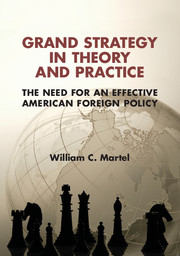Book contents
- Frontmatter
- Dedication
- Contents
- Acknowledgments
- 1 Introduction
- 2 Contemporary Classics in American Grand Strategy
- Part I Makers of Grand Strategy
- Part II Makers of American Grand Strategy
- 7 Building Domestic Foundations of American Power: Washington to Lincoln
- 8 Restraining Sources of Disorder: Theodore Roosevelt to Franklin Delano Roosevelt
- 9 Reinforcing Alliances and Partnerships: Truman to Reagan
- 10 Drifting between Principles: Bush to Obama
- Part III Conclusion
- Notes
- Index
10 - Drifting between Principles: Bush to Obama
Published online by Cambridge University Press: 05 January 2015
- Frontmatter
- Dedication
- Contents
- Acknowledgments
- 1 Introduction
- 2 Contemporary Classics in American Grand Strategy
- Part I Makers of Grand Strategy
- Part II Makers of American Grand Strategy
- 7 Building Domestic Foundations of American Power: Washington to Lincoln
- 8 Restraining Sources of Disorder: Theodore Roosevelt to Franklin Delano Roosevelt
- 9 Reinforcing Alliances and Partnerships: Truman to Reagan
- 10 Drifting between Principles: Bush to Obama
- Part III Conclusion
- Notes
- Index
Summary
This chapter focuses on the United States as a great power after the Cold War ended with the Soviet Union’s collapse in 1991. By the late twentieth century, the United States had established itself as a political, economic, and military superpower and the “leader of the free world” whose grand strategy, however, began to show signs of drift, reactiveness, and overcorrection. As the post–Cold War era unfolds, America’s grand strategy moves from strictly containing the USSR to dealing with myriad challenges, ranging from state-based threats, such as China, Russia, and Iran, to complex transnational threats, notably terrorism, nuclear proliferation, and economic instability.
The post–Cold War world presented a double-edged sword. It was a great accomplishment for the West to defeat the Soviet Union and usher in another wave of the spread of democracies. Yet, it was also a period of daunting challenges for the United States. But in the absence of a single, identifiable adversary, American grand strategy entered a period of drift and imbalance, often in the direction of being highly reactive to events. In this period, the three previous eras in the evolution of grand strategy – modern, revolutionary, and nuclear – overlapped to eventually coalesce into a complex mosaic of threats.
- Type
- Chapter
- Information
- Grand Strategy in Theory and PracticeThe Need for an Effective American Foreign Policy, pp. 300 - 336Publisher: Cambridge University PressPrint publication year: 2015



